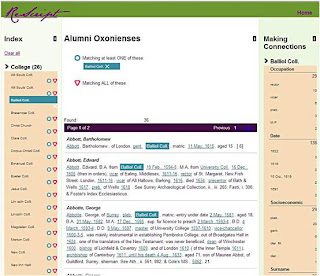Search legend
Heuristic
Learnability
Description
When starting an additional search, users often forgot to click on either “Clear All”, or to clear search terms individually, before starting a new search.
Impact severity
High
Recommend
Add “Clear All” function to the search legend, plus link to edit search using the Super Search form.
Examples
Users were asked to conduct a search to find all members of Balliol College, and then to conduct a search to find all MPs.
 |
| Figure 3—1: there is no way of replacing the current search criteria |
You have completed a search on Balliol College. You now want to start a new search for all records with the name “Abbott” in the Alumni Oxonienses. Where do you click first?Actual question
You have completed a search on Balliol College. To start a new search for all records with the name "Abbott" where would you click first?Initial click test result ('before')
September 2011: 89 responses.
 |
| Figure 3—2: Before |
Development change
Historians typically create large amounts of textual content as they search, so increasing the size of the search input box and including an easy-to-find ‘Clear’ button is a natural step which will help (and hopefully prompt) users to refine their queries effectively (e.g. search for 'Balliol' in the Alumni).
 |
| Figure 3—3: A large text area is provided for users to play around with their search criteria, accompanied by a simple 'Clear' button |
November 2011: 330 responses.
 |
| Figure 3—4: After |
Clearly, the larger area covered by the search input drew the majority of users in, although some preferred the option in the page header. Some users may have been confused by the question and went straight to the first search result, entitled 'Abbott'. Fewer went for the Clear button, a simple example of personal preference which the site can support.
By this point in the analysis, it is easier to discern the amount of random clicks which the survey attracted, and use that impression as a mental filter for all of the screens in the survey.
Bruce Tate, Project Manager
Donna Baillie, Project Officer









